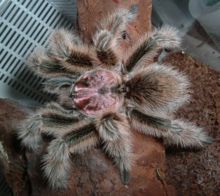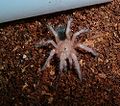- Chilean rose tarantula
-
Chilean rose tarantula 
An adult male Grammostola rosea Scientific classification Kingdom: Animalia Phylum: Arthropoda Class: Arachnida Order: Araneae Suborder: Mygalomorphae Family: Theraphosidae Genus: Grammostola Species: G. rosea Binomial name Grammostola rosea
(Walckenaer, 1837)Synonyms Citharoscelus kochii
Citharoscelus spatulatus
Grammostola argentinense
Grammostola argentinensis
Grammostola cala
Grammostola spathulata
Grammostola spatulata
Eurypelma rosea
Eurypelma spatulatum
Lasiodora rosea
Mygale rosea
Mygale rubiginosa
The Chilean rose tarantula (Grammostola rosea), also known as the Chilean flame tarantula, Chilean fire tarantula or the Chilean red-haired tarantula or the Chilean rose hair tarantula (depending on the colormorph), is probably the most common species of tarantula available in pet stores today, due to the large number of wild-caught specimens exported cheaply from their native Chile into the US pet trade.
G. rosea originates in the northern Atacama Desert region of Chile, where it lives in the driest deserts on earth. G. rosea is a common pet of tarantula rearers. Females have been known to live as long as 15–20 years, but due to the limited time they have been available on the market (and hence for extensive study) it is possible that they may live considerably longer than 20 years.Contents
Habitat
The G. rosea's natural habitat is the desert and scrub regions of Northern Chile, Bolivia, and Argentina.[1] While previously thought to be wanderers in nature, large numbers have been observed living in burrows in their natural habitat. They generally do not burrow in captivity. They are usually active in the evening or night.
Food
This tarantula has a diverse menu including grass hoppers, crickets, moths, beetles, cockroaches and mealworms. It can also grab hold of a pinky mouse. When tarantulas are kept as pets, the best food that can be provided for them are crickets that have been gut loaded on vegetables, as this is the best source of hydrated nutrition for the tarantula.
Reproduction
The Grammostola rosea has been bred in captivity for years either for research purposes or for trade and Gurley, R (n.d) states that the females profit from a ‘cooling period’ of a couple of months proceeding to the introduction of a male for mating. Once a male has reached sexual maturity he will create a sperm web before he is introduced to the female’s terrarium. He will eventually approach the female’s burrow with caution, tapping and vibrating his legs to attract her out of her shelter. At the opportune moment the male will lunge himself forward and using his hooks he will hold the female's chelicerae, pushing his mate into a vertical position giving him access to the female’s epigyne (external genitalia). The male will insert one (or even both left and right) pedipalp into the female's epigyne and inject the fertilizing fluid. Gurley, R (n.d) continues that in the weeks following fertilization, the female produces a large egg sac (usually containing around 500 spiderlings) and the male dies.
Pets
Gramostola rosea are relatively docile, low maintenance, and inexpensive, so they are popular as pets. G. rosea can be kept with relatively low humidity, overflowing the water dish one or two times a week should provide ample humidity for this species. A terrarium at least triple the spiders' legspan in length, with a retreat for hiding. They are quite happy living at temperatures of around 25-30°C, with a diet of four to six crickets every three weeks (or one locust per week). The G. rosea's feeding schedule is rather erratic, however; the spider can fast for weeks to months at a time. Fasting is sometimes an indication of an upcoming moult.
Grammostola rosea are usually skittish, running away from danger rather than acting defensively, but they may also raise their front legs and present their fangs in preparation to defend themselves. They can act especially defensive for days after moulting; this may be innate in the spiders behavior. As with the majority of tarantulas from the Americas (New World tarantulas), they have small spine-like urticating hairs on their abdomen that they kick off or release when threatened as a defense.[2]
In February 2009 a British man was treated for tarantula hairs lodged in his cornea.[2] The hairs were thrown from the man's pet G. rosea while the man was cleaning its tank. Medical authorities urge owners to wear protective eyewear when handling a G. rosea.[2]
Gallery
Notes
- ^ Muller-Esnault, Susan, DVM. "Rose Hair Tarantulas or Chilean Rose Hair" (2008). http://www.critterology.com/rose_hair_tarantulas_or_chilean_rose_hair-192.html
- ^ a b c "Tarantula shoots sharp hairs into owner’s eye". MSNBC. Jan. 1, 2010. http://www.msnbc.msn.com/id/34647048/ns/health-pet_health/. Retrieved 3 January 2010.
References
Gurley, R, n.d., Rose-haired Tarantula: Chilean Rose-haired Tarantula, Animal World, retrieved 21 May 2010. < http://animal-world.com/encyclo/reptiles/spiders/rosehairtarantula.php> Marshall, Samuel D. Tarantulas and Other Arachnids. Barrons, 2001. ISBN 07641146 Schultz, Stanley A. The Tarantula Keeper's Guide: Comprehensive Information on Care, Housing, and Feeding. Barrons, 2009. ISBN 0764138855
External links
- Grammostola rosea at care-sheet.com (WikiPets)
- Grammostola rosea photography Tarantula breeding, site of Czech Ondrej Rehak
Categories:- Theraphosidae
- Spiders of Chile
- Animals described in 1837
Wikimedia Foundation. 2010.



